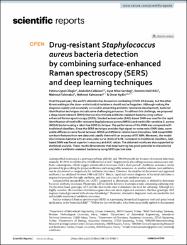Drug-resistant Staphylococcus aureus bacteria detection by combining surface-enhanced Raman spectroscopy (SERS) and deep learning techniques

Göster/
Tarih
2021Yazar
Çiloğlu, Fatma UysalÇalışkan, Abdullah
Sarıdağ, Ayşe Mine
Kılıç, İbrahim Halil
Tokmakçı, Mahmut
Kahraman, Mehmet
Aydın, Ömer
Üst veri
Tüm öğe kaydını gösterKünye
Ciloglu, F. U., Caliskan, A., Saridag, A. M., Kilic, I. H., Tokmakci, M., Kahraman, M., & Aydin, O. (2021). Drug-resistant Staphylococcus aureus bacteria detection by combining surface-enhanced Raman spectroscopy (SERS) and deep learning techniques. Scientific reports, 11(1), 18444. https://doi.org/10.1038/s41598-021-97882-4Özet
Over the past year, the world's attention has focused on combating COVID-19 disease, but the other threat waiting at the door-antimicrobial resistance should not be forgotten. Although making the diagnosis rapidly and accurately is crucial in preventing antibiotic resistance development, bacterial identification techniques include some challenging processes. To address this challenge, we proposed a deep neural network (DNN) that can discriminate antibiotic-resistant bacteria using surface-enhanced Raman spectroscopy (SERS). Stacked autoencoder (SAE)-based DNN was used for the rapid identification of methicillin-resistant Staphylococcus aureus (MRSA) and methicillin-sensitive S. aureus (MSSA) bacteria using a label-free SERS technique. The performance of the DNN was compared with traditional classifiers. Since the SERS technique provides high signal-to-noise ratio (SNR) data, some subtle differences were found between MRSA and MSSA in relative band intensities. SAE-based DNN can learn features from raw data and classify them with an accuracy of 97.66%. Moreover, the model discriminates bacteria with an area under curve (AUC) of 0.99. Compared to traditional classifiers, SAE-based DNN was found superior in accuracy and AUC values. The obtained results are also supported by statistical analysis. These results demonstrate that deep learning has great potential to characterize and detect antibiotic-resistant bacteria by using SERS spectral data.















